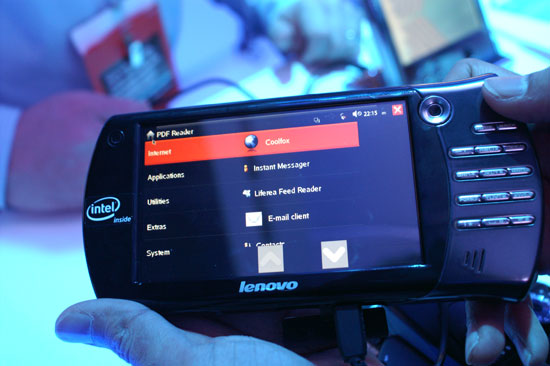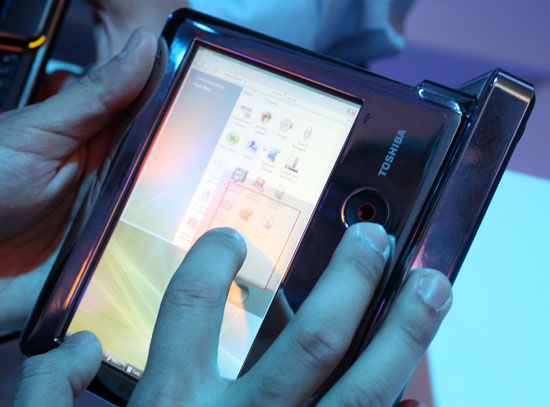Intel's Menlow Revealed: Baby Centrino Gets Ready
by Anand Lal Shimpi on January 9, 2008 12:00 AM EST- Posted in
- CPUs
Menlow Based MIDs
Because of the size and power consumption of Menlow, it will only end up in Mobile Internet Devices (MIDs). We took a number of pictures of these devices, 25 of which are due out in Q2 of this year. These devices won't be cell phones, but they will support things like web browsing, email, music, pictures and some will even support GPS.
Intel told us that 80 - 90% of these MIDs will be Linux based, only a small percentage will run Vista. The Linux MIDs will have their own custom interfaces, similar to what Apple did for the iPhone, in order to improve usability and keep performance up on these lightweight platforms.


We weren't impressed at all with the MIDs we saw at the show. The ones that ran Linux had decent interfaces but they weren't anywhere near as smooth or intuitive as what Apple created for the iPhone. While these devices are aimed at a very different market, it doesn't mean that the companies making them can't learn from what Apple has done already.
We played with one Vista based MID which was absolutely horrible. The performance was beyond terrible and the desktop UI on a 5" screen just wasn't usable.

Manufacturers still have a few months to work out the kinks, and Intel is confident that there will be some gems among these first Menlow based MIDs, but we remain skeptical.
















22 Comments
View All Comments
PandaBear - Wednesday, January 9, 2008 - link
I don't understand why would Intel try to force x86 down a portable device that runs on Linux. For Windows I can understand but ARM (and almost every other architecture out there) can run Linux and in an embedded device you don't want to have the cost and power consumption much more than ARM.Given the fact that ARM based solution are so efficient power wise, and that there are already many ARM based ASIC out there, I don't understand why (other than politics) would Intel want to go the x86 road. They should develop a similar low power RISC core and hardware accelerated ASIC around it instead.
What I sense is that they don't want x86 to go away when non PC take over the Internet browsing and mobile market takes off. So they give you something that is just good enough to hang on to rather than going to an all new platform like iPhone. Without a true Windows (with good usability) this won't help much.
defter - Thursday, January 10, 2008 - link
Intel had a low-power RISC core called StrongARM several years ago, but they decided to sell that...It seems that Intel feels it's important that small mobile devices use the same instruction set as desktop PCs.